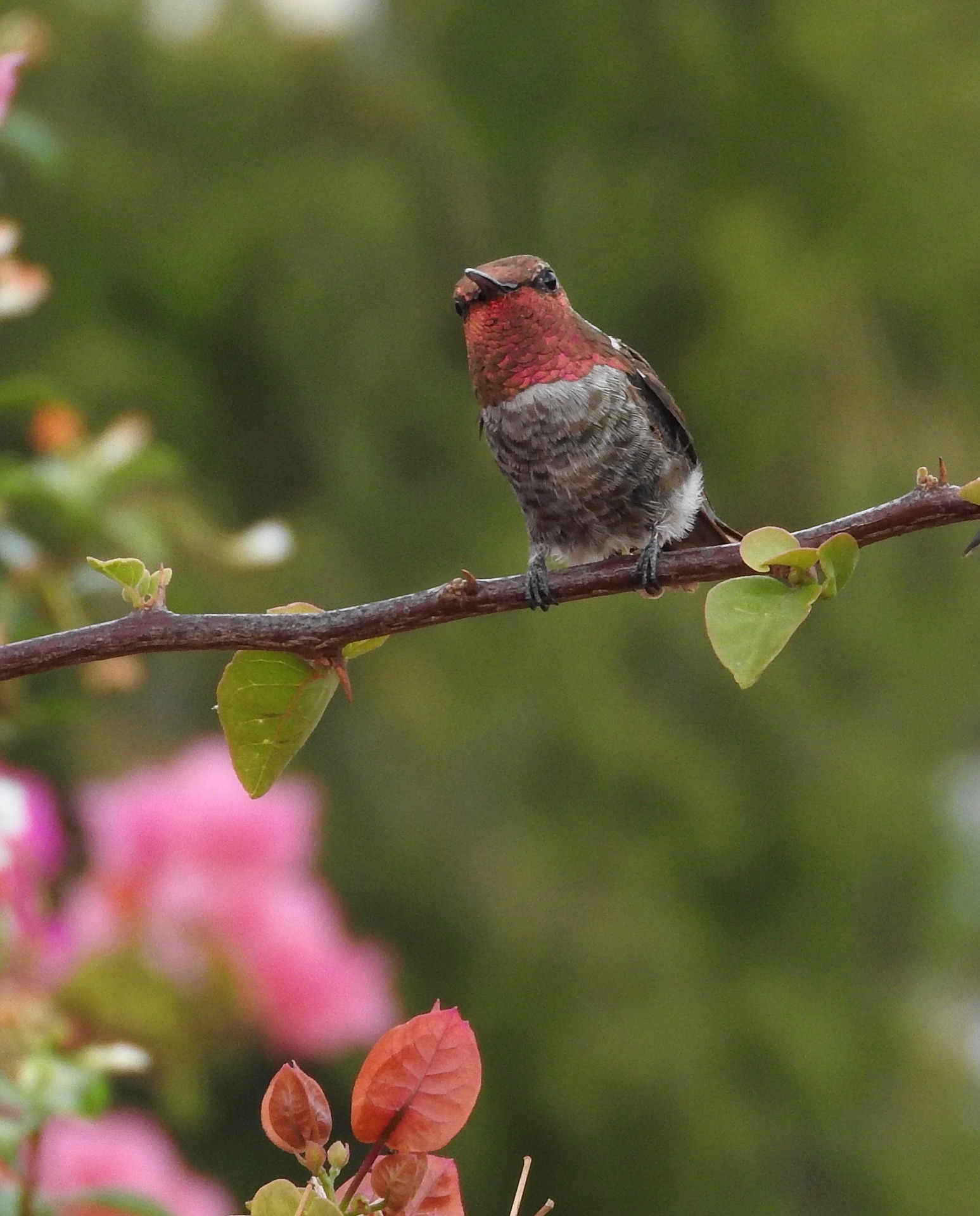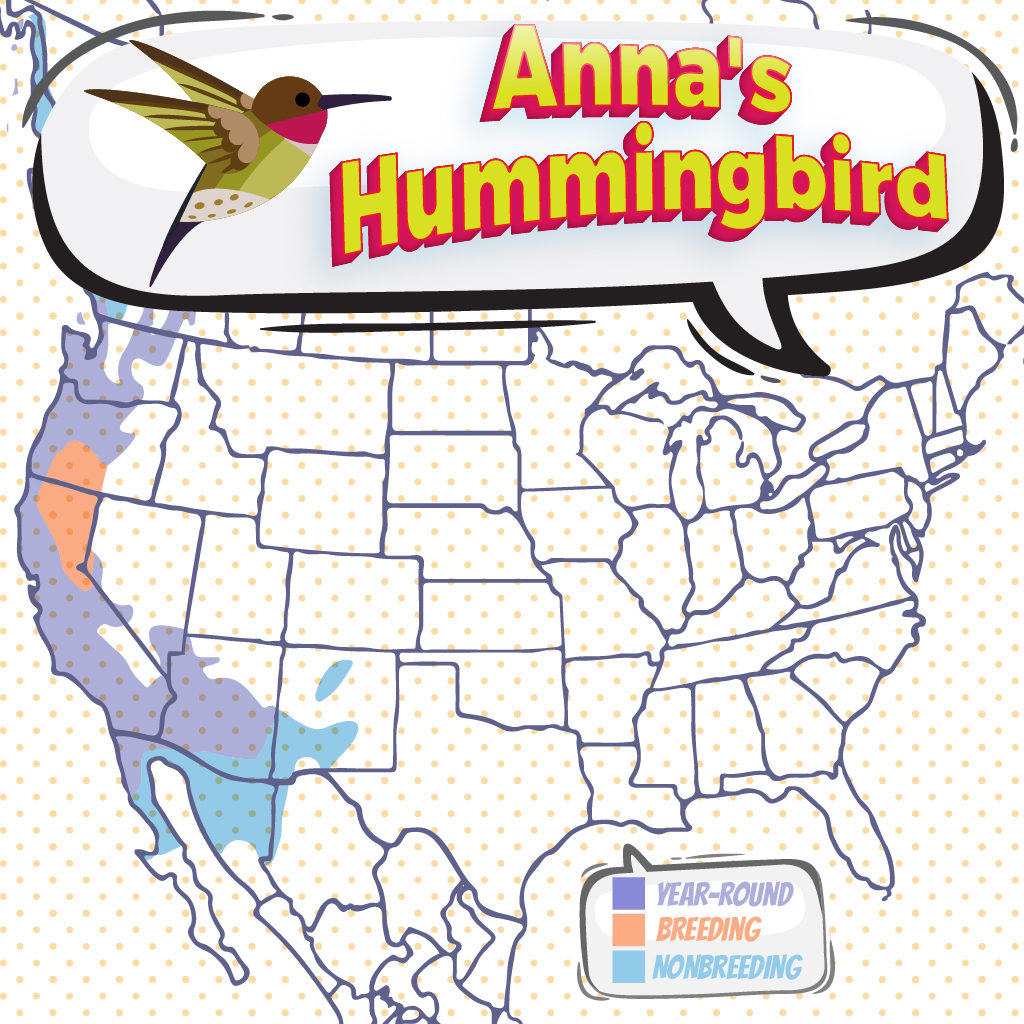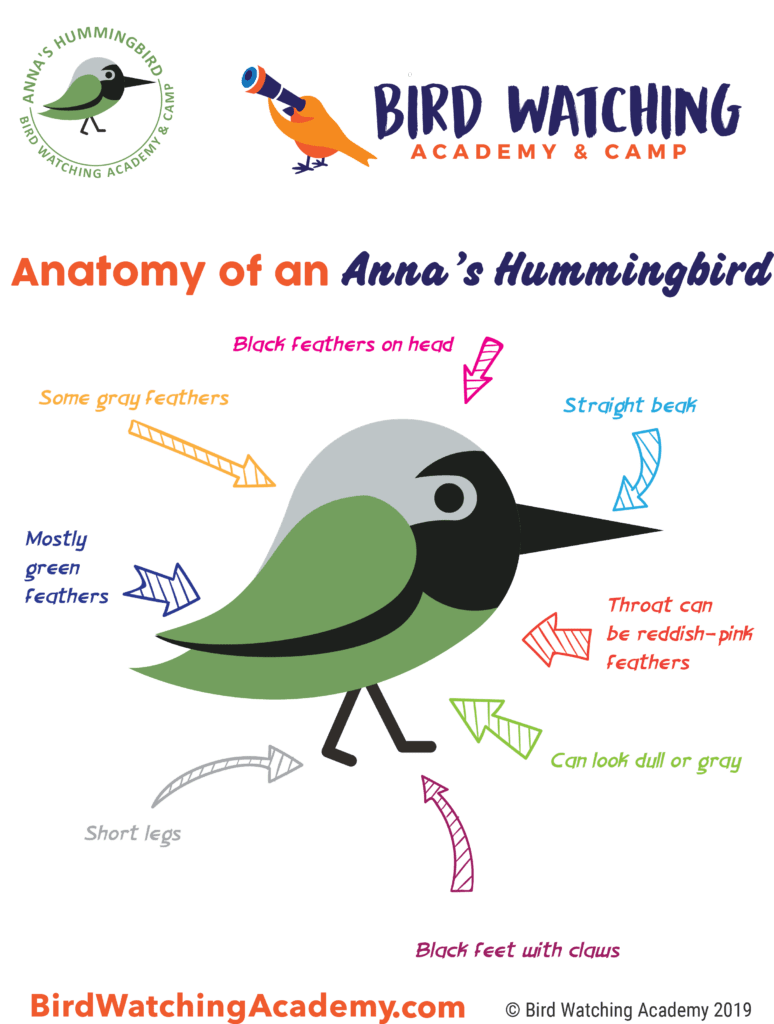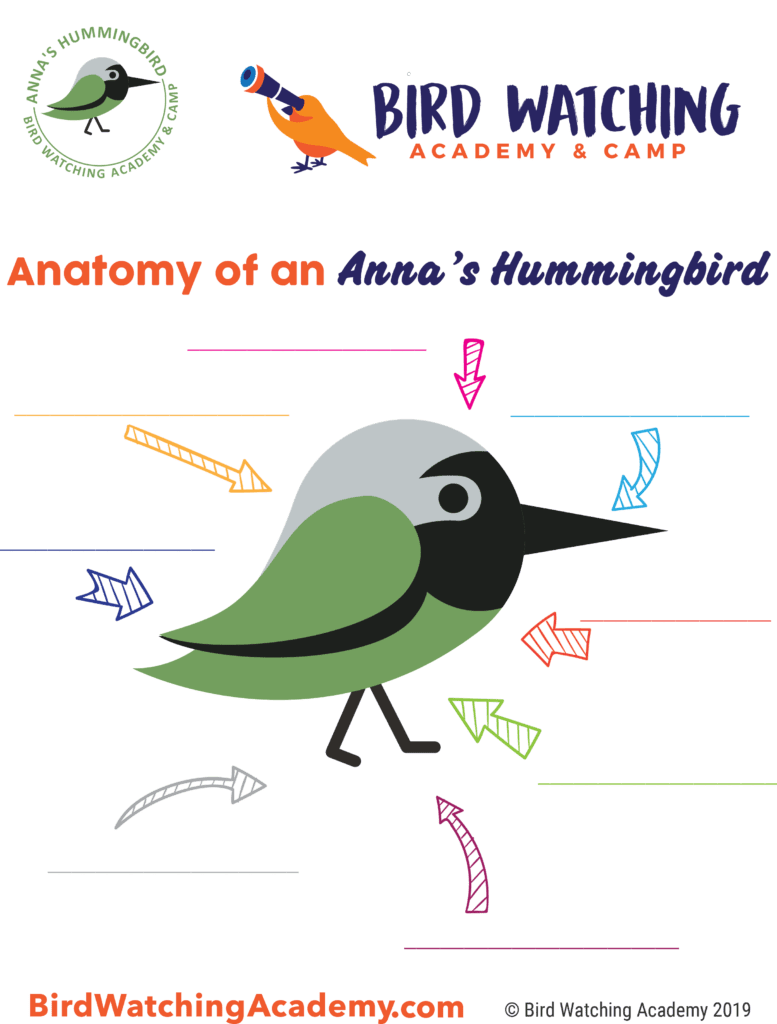
Anna’s Hummingbird is a fun bird to see while bird watching. Below are some tips to help you identify Anna’s Hummingbirds. We have also put together a list of fun Anna’s Hummingbird t-shirts, Anna’s Hummingbird bird patches, birdhouses, bird feeders, binoculars, stickers, and other fun bird watching items.
About Anna’s Hummingbird
Named after Anna Messena is Anna’s Hummingbird bird located along the Pacific coast. With its iridescent feathers and vast agility, it is revered as one of the most beautiful birds in the world.
Description and Identification
Even though Anna’s Hummingbird is a common species, they are anything but common in their appearance. They have emerald feathers and sparkling rose-pink throats. The bill is black and straight, the back of the neck is green. The chest, abdomen, and sides are grey with a green tint. The wings and tail are dark dusky black-brown and there is a pale, broken eye-ring. The females have slightly longer bills and dark red spots on the chest, abdomen, and sides, the wings, and tail are dark with white spots on the outer tail feathers and they have a white patch over the eye. They are no bigger than a ping-pong ball and no heavier than a nickel.
Anna’s Hummingbird Color Pattern
The iridescent Anna’s Hummingbird is mostly green and gray in color. Both the male’s head and throat are covered in plum-pink feathers that almost look slightly dull brown without enough direct sunlight.
Anna’s Hummingbird Size
These birds are very pint-sized, barely as big as a ping pong ball, and lighter than a nickel. Both sexes are about the same size. They are 3.9 inches in length, weigh 0.1-0.2 ounces, and have a wingspan of 4.7 inches.

Anna’s Hummingbird Behavior
Anna’s Hummingbird is the bird known to be able to fly forward, backward, upwards, sideways, or have the ability to sit in utter space. This is because the bird can rotate each of its wings in a complete circle. This bird is very territorial and it does everything in its power to protect itself and its territory.
Anna’s Hummingbird Diet
Anna’s Hummingbirds are the carnivores of Hummingbirds. They feast on nectar from flowers, they feed on tiny insects and spiders that they catch in the air or glean from tree trunks and branches. They also visit Sapsucker holes to sip at small quantities of sap, especially when flower nectar is scarce. They feed about 5-10 times per hour for 30-60 seconds each time.
Anna’s Hummingbirds feed on sweet nectar from flowers, food placed in feeders, and spiders and insects. This species of Hummingbirds consume more insects than any other American hummingbird. They feed about 5-10 times per hour for 30-60 seconds each time.
Anna’s Hummingbird Habitat
Anna’s Hummingbirds are mostly found around nectar-producing plants. They prefer open woodland and scrubby riparian habitats including open woods. The traditional habitat of these birds is the Chaparral. This bird is very territorial and it does everything in its power to protect itself and its territory.
These birds are common around flowering plants, gardens, parks, yards, savannahs, and coastal shrubs. They mostly enjoy the coastal regions because of it being a prime location for the growth of many nectar-producing plants.
Nesting
Males and females do not form lasting pair bonds and are polygamous. The males perform spectacular courtship displays by diving from 130 feet in the air, swooping to the ground in front of females, and creating a buzz through their tail feathers at the bottom of their dive. Females construct the nest, incubate the eggs, and feed the nestlings on their own. The nesting and rearing of young birds are up to the female. She builds a tiny, compact cup-shaped nest using plant fibers tied together with spider silk, lined with plants and feathers, and decorated with moss or lichen for camouflage. The spider webs and insect cocoons hold the fibers of cattail, willow, thistle, and small feathers together. The females sit in the nest while they build the rim up around themselves, working for up to a week to complete the 1-inch tall construction. The females build their nests on a wide variety of surfaces, most often on the branch of a shrub or tree at heights varying from 3-27 feet from the ground, situated near suitable food sources. The female incubates two eggs for 14-19 days. She feeds and cares for them by herself until they become independent at 18-23 days.
Range and Migration

Anna’s Hummingbirds are a non-migratory breed of Hummingbirds that are native to western coastal regions of North America. They occur from the Alaskan coast to Northern Mexico, Anna’s Hummingbird is found mainly in California during its breeding season. Southwestern birds migrate east-west returning in late summer. They don’t migrate south and north; these birds are altitudinal migrants, they move to higher elevations in summer and lower in winter.
Anna’s Hummingbird Lifecycle
Anna’s Hummingbird’s mating season lasts up to about six months, allowing the female to hatch two sets of eggs during that time. After breeding, the female is responsible for building the nest, sitting on the eggs, and caring for the young after they hatch. Young Anna Hummingbirds nest for 18 to 23 days after which they are ready to leave the nest.
Anatomy of an Anna’s Hummingbird
Anatomy is the study of animals or other organisms and their parts. Bird Anatomy is the study of birds and their parts. Birds have beaks, wings, talons, feathers, and other parts that are important to learn about. Learning about bird anatomy will also help kids learn how to identify birds. We focus on the exterior, external, or outside anatomy of birds to help kids learn how to identify them.
Some other types of bird anatomy are the skeletal system, muscular system, circulatory system, respiratory system, and digestive system. Birds also have reproductive systems, nervous systems, and immune systems. Birds are amazing creatures.
Ornithology
FREE PRINTABLE BIRD ANATOMY INFOGRAPHIC
Here is a fun printable design to help kids learn about Anna’s Hummingbirds.
CLICK HERE TO DOWNLOAD AND PRINT THIS FILE Bird Anatomy Anna’s Hummingbird

Below is a blank copy to test your kids on the bird anatomy of an Anna’s Hummingbird.
CLICK HERE TO DOWNLOAD AND PRINT THIS BLANK TEST FILE Bird Anatomy Anna’s Hummingbird Test

Bird Watching Academy & Camp Subscription Boxes
At the Bird Watching Academy & Camp we help kids, youth, and adults get excited and involved in bird watching. We have several monthly subscription boxes that you can subscribe to. Our monthly subscription boxes help kids, youth, and adults learn about birds, bird watching, and bird conservation.
- Kids Bird Watching Monthly Subscription$10.00 / month
- Kid & Adult Bird Watching Starter Pack Subscription$10.00 / month and a $72.00 sign-up fee
- Kids Bird Watching Starter Pack Subscription$10.00 / month and a $19.00 sign-up fee
Bird Watching Binoculars for Identifying Anna’s Hummingbirds
The most common types of bird watching binoculars for viewing Anna’s Hummingbirds are 8×21 binoculars and 10×42 binoculars. Bird Watching Academy & Camp sells really nice 8×21 binoculars and 10×42 binoculars. You can view and purchase them here.
- Birding Binoculars$49.99
- Kids Binoculars$13.99
Anna’s Hummingbird Stickers
Stickers are a great way for you to display your love for bird watching and Anna’s Hummingbird. We sell a monthly subscription sticker pack. The sticker packs have 12 bird stickers. These sticker packs will help your kids learn new birds every month.
Bird Feeders For Anna’s Hummingbird
There are many types of bird feeders. Bird feeders are a great addition to your backyard. Bird feeders will increase the chances of attracting birds drastically. Both kids and adults will have a great time watching birds eat at these bird feeders. There are a wide variety of bird feeders on the market and it is important to find the best fit for you and your backyard.
Best Bird Houses for Anna’s Hummingbird
There are many types of bird houses. Building a bird house is always fun but can be frustrating. These 4 bird houses have become our favorites. Getting a bird house for kids to watch birds grow is always fun. We spent a little extra money on these bird houses but they have been worth the higher price and look great.









